French Complicity in the Origin and Cover-up of Covid
French state media recently broadcast a documentary which seems to support the possibility of an artificial origin of Covid. This is a watershed in European coverage. How sincere is this new openness?
The documentary comes amid tantalizing (although still unsubstantiated) rumors from US, German and Italian IC sources. The media coverage triggered further action. The French Academy of Medicine declared a lab accident a realistic possibility, and a group of scientists and journalists published an open letter in Le Monde, calling for a parliamentary commission into the possibility.
The conversion wasn’t really sudden or dramatic as it seems. Some French scientists have long been open to an artificial origin - but nuance matters. An artificial pathogen resulting from some misguided, but perhaps morally justifiable motive is acceptable, but that it was deliberately designed to be a bioweapon - is not.
Arguments against a bioweapon are various: it isn’t well-targeted, would attack civilians/military alike, it is difficult to control, there’s no effective vaccine, it isn’t lethal enough for battlefield use. But this isn’t scientific evidence. These are presumptions about the objectives and willingness of a regime to engage in biowarfare (or bioterrorism), and their tolerance of collateral damage to their own people and economy. Perhaps intelligence agencies, and dissidents/defectors who lived under the CCP are better placed to assess the scenarios than are western scientists.
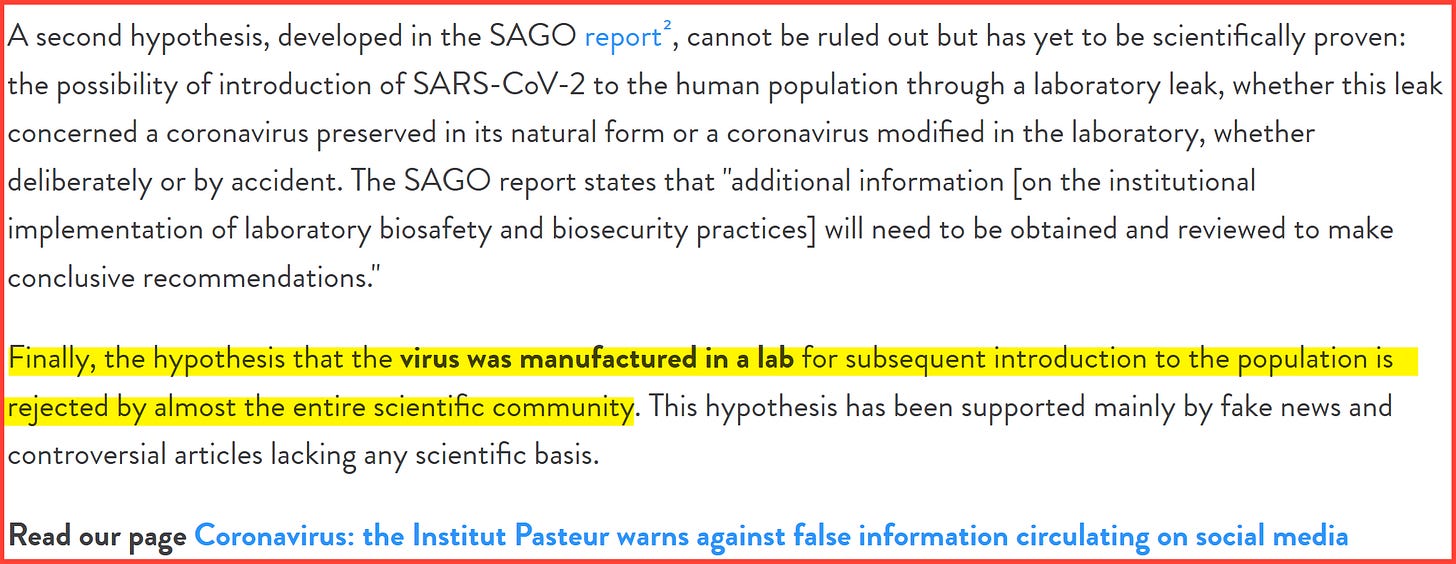
Institut Pasteur’s Marc Eloit is the senior author of the Banal sequences - which include the closest known bat virus to SARS-CoV-2. Eloit has always been open to the possibility of a lab origin. The Banal sequences don’t include a furin cleavage site (FCS) so they leave open the possibility one was artificial inserted. But if they are genuine (which I question) they support that several other anomalous genomic features of SARS-CoV-2 are natural. These include the receptor binding domain (RBD) - which is key to its affinity for humans, the N-terminal Domain (NTD) - which may well explain its multi-systemic tropism (including respiratory transmission and neurotropism) and ORF8, which strongly influences the immune response.
Can all this respiratory transmissibility and virulence have evolved in an enteric bat virus? That is the inherent claim of these sequences, and not one we should accept without question. Sequences (and also the files they are assembled from) are plain text files, easy for someone with expertise to fabricate. The system is based around trust in the submitter. While Institut Pasteur is a storied institution that has produced many Nobel laureates, it has also been enmeshed in collaborations with Chinese state and military scientists.
From Barefoot Doctor to B-52s
Immediately after the infamous teleconference involving Fauci, the “Proximal Origins” authors, and European scientists, Jeremy Farrar contacted a backchannel in China to discuss their concerns over an artificial origin. That was China’s former Minister of Health, Chen Zhu (at the time still Vice Chair of the National People’s Congress).
Chen is a Francophile who did his PhD and postdoc study in France. Later, as Vice President of China’s Academy of Science (CAS), he was the main driver of the project with France to design and construct the Wuhan P4 lab. Integral to this was the creation of Institut Pasteur Shanghai (IPS), a joint venture with CAS, which was intended to provide an ongoing presence of international scientists at the lab, which had been initially planned for Shanghai.
Chen’s French counterpart in overseeing the lab construction, the founding of IPS and other Sino-French collaborations was biotechnology businessman and philanthropist Alain Mérieux. Mérieux was also a long-time Sinophile and the two became great friends.
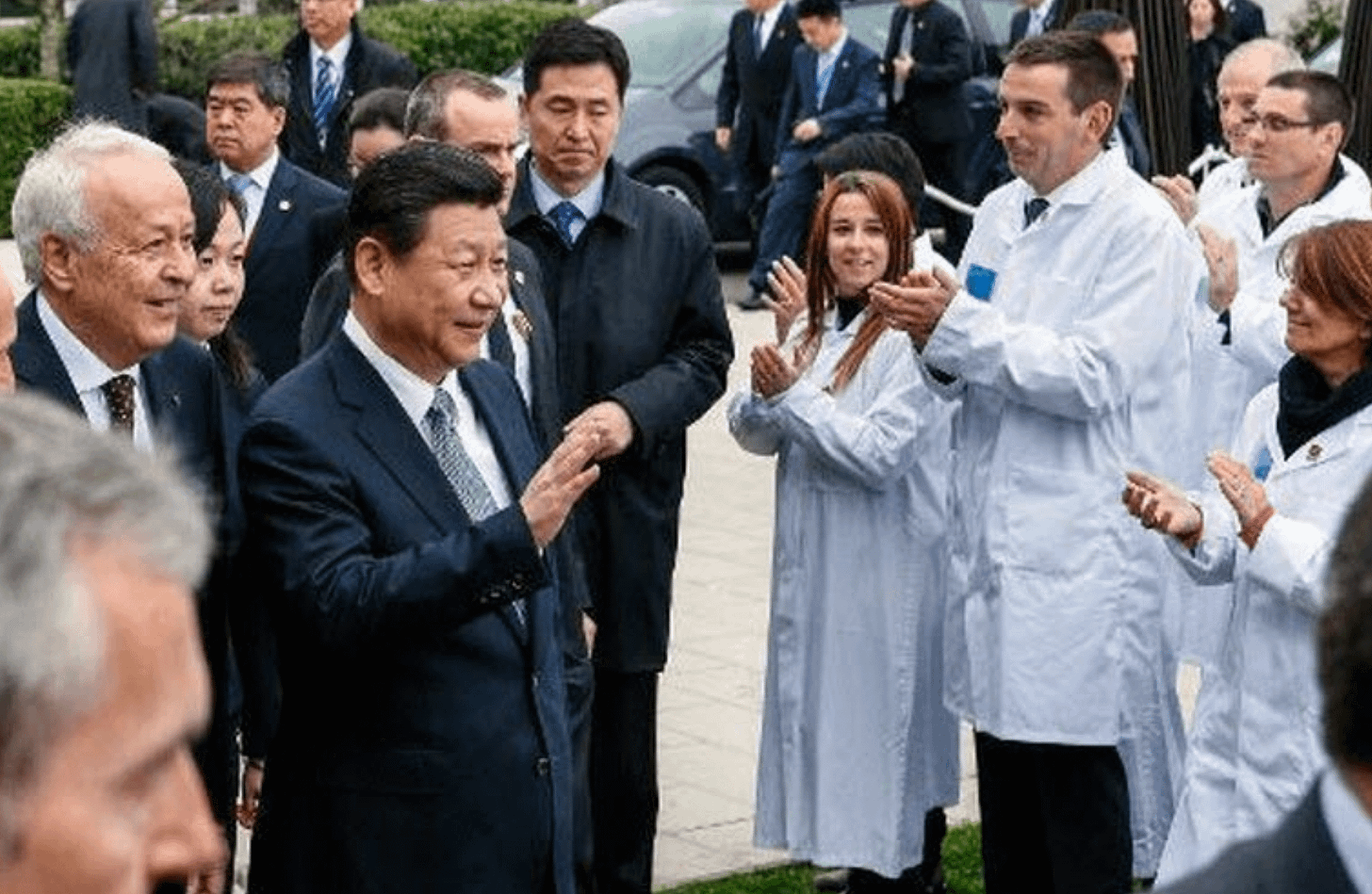
Chen and Mérieux had more recently been organizing a new collaboration on bio-surveillance at the request of Xi Jinping. This would have seen the Indochinese outposts of Institut Pasteur and Mérieux Foundation help China in the search for novel zoonotic pathogens on the other side of the Yunnan border in Laos, Cambodia and Vietnam. This would have expanded into new territory a long running project which had involved several “State Key Labs” including WIV and the PLA’s Academy of Military Medical Sciences (AMMS). But for unknown reasons this agreement wasn’t signed as anticipated.
Farrar’s conversation with Chen seems to have triggered an immediate response. The next day Tommy Lam, a former postdoc of Edward Holmes, called to tell him about the similarities of the RBD of pangolin coronaviruses to that of SARS-CoV-2. Holmes was apparently swayed by this new evidence and co-authored a paper with Lam and several members of the AMMS.
The same day, Anthony Fauci was contacted about a USD$118 million offer to fund Harvard Medical School and Guangzhou Respiratory Disease Research Center which would include a joint study the origin of the new coronavirus. This appears to have been an effort to circumvent an independent international inquiry being proposed by others. Only the first tranche of $12 million was ever received.
On February 14th the Chinese Ambassador to France Lu Shaye visited Institut Pasteur in Paris with a delegation of scientists. Ongoing and proposed collaborative projects were discussed. Institut Pasteur Shanghai was central to these collaborations.
In a twist of fate, also on February 14th, Pyotr Pavlensky, a Russian émigré known for provocative performance art released images “sexted” by the Republican candidate for Mayor of Paris two years earlier, to a now ex-girlfriend. Barely a scandal by French standards, but it was decided a new mayoral candidate was needed.
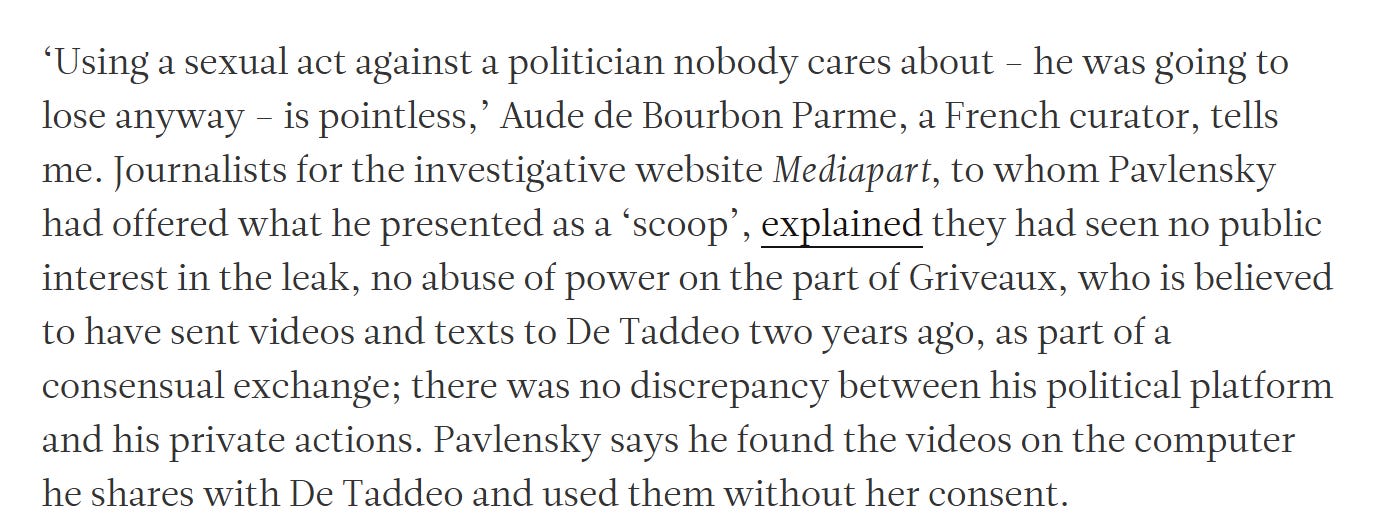
Two days later the replacement candidate was announced: Agnès Buzyn - at the time France’s Minister of Health, amid a growing health crisis. Inevitably she lost the mayoral election (it wasn’t close, she came 3rd), but had resigned as Health Minister in order to run.
Intriguingly, the recent documentary revealed she had feared an artificial origin almost from the outset, and had sent strong warnings to both Prime Minister Édouard Philippe, and President Macron.
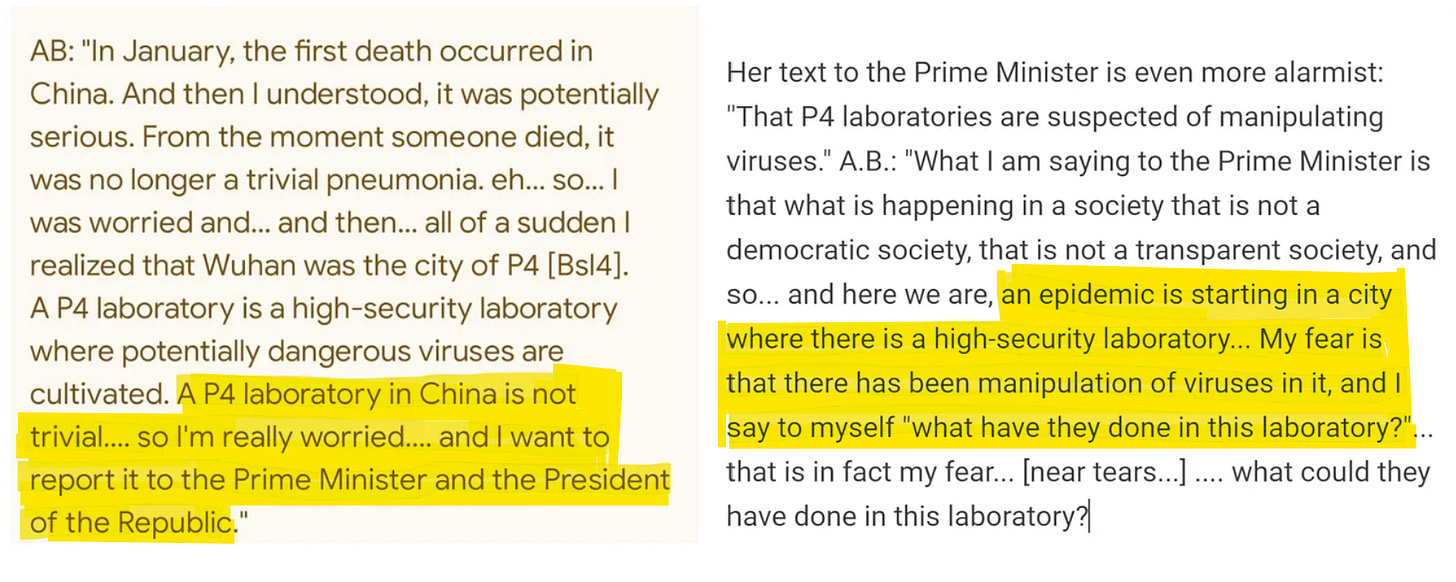
Buzyn is no conspiracy theorist, and her concerns should not have been readily dismissed. She is a qualified medical doctor, PhD immunologist, researcher and professor. Her husband, Yves Levy, is CEO of INSERM (the French equivalent of NIH). Levy had expressed concerns about biosecurity, and potential for nefarious use of the Wuhan P4 lab long before it opened. So had French intelligence agencies.

Ian Lipkin is also a friend and colleague of Chen Zhu since the SARS-1 period. Lipkin was also involved in setting up IPS in 2004. The US Select Subcommittee interview with Lipkin revealed he and Chen were engaged in ongoing email correspondence over the origin. Lipkin appears to downplay US suspicions of a natural origin to Chen, but proposes international involvement in an origin search.
Chen’s response is to insist that WIV would have to be involved in origin collaboration, but that it might be too controversial at the current time.
France’s China boosters were unrepentant about their involvement in the P4. Former Institut Pasteur/INSERM/Mérieux director, and WIV advisory board member, Christian Bréchot, was defiant - appalled at the "rumor the virus had been manufactured" and railing against "anti-Chinese sentiment".
In May 2020, Alain Mérieux announced he would strengthen co-operation between his organizations and WIV/CAS. Institut Pasteur Shanghai announced they had recently recruited more scientists to expand the research collaboration between France and China.
What were these projects, and which scientists were involved in them?
Once scientist who seems a likely candidate is Cui Jie (another former postdoc student of Edward Holmes). While based at WIV, in July 2018 Cui uploaded ~160 partial sequences to GenBank consisting of the RdRp, ORF8 and Spike genes of ~55 unpublished viruses. But he didn’t make them public. They only came to light in 2022, after an automatic embargo expired after 4 years. They were briefly visible to all, then hidden again (however they can still be downloaded with the right accession).
One of these viruses was Ra4991 - now known as RaTG13 (for a while the closest known relative of SARS-CoV-2). But for Ra4991/RaTG13 the all-important Spike gene was missing. In June 2019, a graduate student supervised by Cui submitted a master’s thesis which described the sequencing of Ra4991/RaTG13. The thesis provided statistical comparisons to SARS and other viruses. It also included a sequence alignment of the RBDs of some 50 viruses. Once again, Ra4991/RaTG13 was conspicuously absent.
But the thesis states that Ra4991 had been fully sequenced, and it appears in a table comparing its similarity to SARS in each gene. Why was its spike sequence kept hidden?
There’s another intriguing feature to this table. Another virus, Rs8561, has almost the same nucleotide identity - in each gene - to SARS, as Ra4991 does. Rs8561 was another of the sequences Cui has kept hidden on GenBank. It turns out Rs8561 is very similar to another bat virus ZC45, even though Rs8561 is from Guangdong, and ZC45 from Zhoushan, ~1500km apart. Rs8561 and ZC45, are in turn very different to Ra4991, so is it just an uncanny co-incidence?
There are many uncanny co-incidences in this saga. Another is that ZC45 was published (by the PLA’s Nanjing Command) mere hours after the DEFUSE collaborators submitted their proposal to DARPA. DEFUSE wanted to find viruses ~20% distant to SARS, and ZC45 was the first published virus that met that criteria (it was also the first published virus related to SARS-CoV-2). Later the PLA published a paper showing it could infect immune suppressed mice - another box checked. WIV (a DEFUSE partner) in fact had 4 viruses very similar to ZC45 which would have been ideal, but they kept them secret - even when they later published papers discussing ZC45.
It isn’t clear what was intended here, but I speculate DEFUSE (had it gone ahead) was a honey-trap to misattribute the origin of a planned outbreak to US scientists. What is clear, is that Cui’s ZC45-like sequences aren’t natural. Science can tell us that - if scientists would look at sequences and trust established principles of molecular evolution, rather than the protestations of their Chinese colleagues.
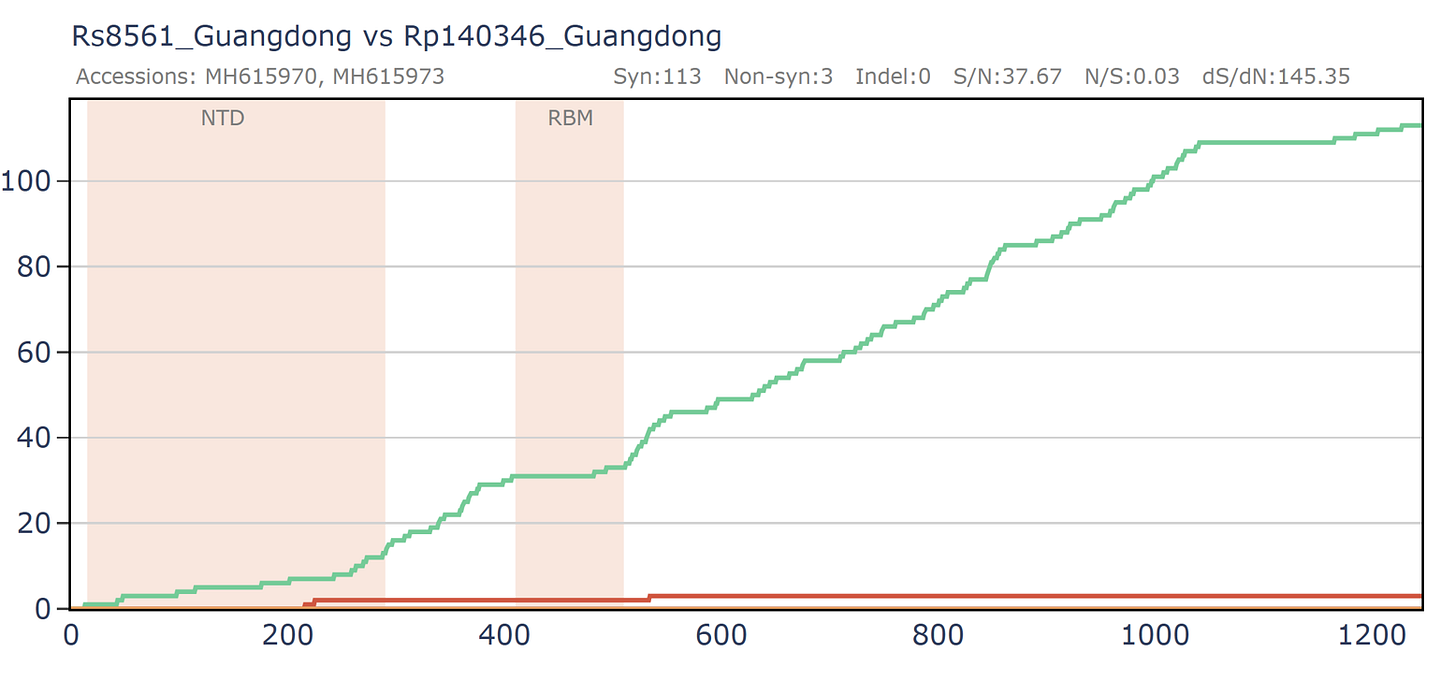
Sometime later in 2019, Cui joined Institut Pasteur Shanghai. It’s likely he remained in Wuhan, while also joining Pasteur’s network. On some papers he uses both WIV and IPS affiliations, later he omits the WIV.
Banalities of Evil
In 2020, Institut Pasteur had only recently ended a project “BatMap” to search for novel bat viruses in Laos. Funded by the US Defense Department, the project began in 2017, had exceeded budget and timelines more than once, and was eventually terminated, but had meanwhile accumulated over 500 samples from bats. These samples are still in Pasteur’s possession, but none have been sequenced. Instead of sequencing these first, Pasteur decided to launch a new field trip to the same caves.
This seems a strange decision during a period of rolling lockdowns and travel restrictions. Perhaps the reason was the planned involvement of IPS. The US DoD funders may not have approved sharing the samples with an entity so close to WIV. But why didn’t they analyze these samples without involving Chinese state scientists?
Perhaps they belatedly considered that. Ultimately no IPS authors were listed on the paper announcing the Banal discovery. In July 2021, two months before their publication, Pasteur Network underwent a reorganization, and IPS was quietly excised from the network.
Nonetheless, collaboration between IP and IPS/CAS/WIV didn’t immediately cease. In another uncanny co-incidence, sequences were uploaded the evening before the Banals by another WIV/IP group, including the former head of virology at IP Laos. Despite being entirely unrelated viruses, there is unexpected homology to SARS in at least one sequence.
The fortuitousness of the Banal discovery is incredible - literally. Before 2020, besides the ZC45 group, only one SARS-CoV-2 like virus had been found (RaTG13), and that is dubious. But Pasteur claimed to have found 5 SARS-CoV-2 like viruses in the first cave they went to (but none at the other 3 sites). Banal-52 is the best known of the 5, as it can explain the evolution of SARS-CoV-2 without relying on a hypothetical recombination. Two others provide support for the widely disparaged pangolin covs, and two have uncanny similarity to RmYN02.
But they raise more questions than they answer. They suggest an evolution where there is no pressure to adapt, even as they switch between multiple bat species, pangolins and humans. They show evidence of frequent recombination at uncannily precise genomic locations, much as earlier dubious WIV “discoveries” claimed to. They have remarkably similar RBDs in bat/pangolin/human.
Some evolutionary biologists have argued to me, that nature found an optimal sequence for all. But in human SARS-CoV-2 variants the RBD is the most variable region of the genome, and even after >20 mutations is still remarkably good at binding human ACE2. The RBD needs to keep evolving to evade immune recognition. That pressure means it can’t ever settle on an “optimum”. It’s a constant game of cat-and-mouse, pathogen-and-host. If the Banals really are natural, they challenge long-established scientific understanding of molecular evolution - they challenge Charles Darwin. We shouldn’t rule it out, but Pasteur should substantiate their case with something more than plain text files of murky provenance.
Unfortunately the Banal sequences didn’t attract the scrutiny earlier sequences did, somewhat due to Pasteur’s high reputation and the unwarranted perception of their independence from China. But also because they don’t include an FCS, they don’t entirely preclude an artificial origin, and some “lab-leakers” welcomed them as more evidence in favor of this. The suggestion was made that because the new closest virus came from Laos, not China - that pointed the finger more strongly at the US (or at least the various members of the DEFUSE consortium).

Validating the Banals is crucial. If genuine we can rule out that SARS-CoV-2 might be a heavily engineered bioweapon, but should be alarmed at the potential threats from nature (SARS-CoV-2 has been shown able to transmit between humans even without an FCS ,and SARS-1 was deadly enough). For most scientists, diplomats, politicians and businesses, this is a more palatable scenario. An unfortunate accident, the remedy is relatively painless: better biosecurity, more oversight, a mild rebuke for China, but we all share some responsibility.
But if they aren’t genuine, the ramifications are deadly serious, because:
They obfuscate unnatural mechanisms of pathogenicity and tropism that should (have) inform(ed) the safe design of vaccines and therapeutics.
They give credence to a hoax theory of viral “evolution by horizontal gene transfer” that can be used to misattribute future bioterrorist attacks.
They allow the culprits of a massive bioterrorist attack to go unpunished. Bioweapon development and proliferation is extremely difficult to detect. The best deterrent is unified international condemnation.
So it is important that France should participate in the investigation. But is France genuinely interested in finding out? Is there an appetite to investigate their own institutions, scientists, business leaders, politicians? French scientists I’ve been in contact with seem more interested in the US engagement with WIV, than their own. The US has taken steps to investigate itself, and these will continue. Daszak, Baric and Fauci have appeared before Congressional hearings and thousands of pages of documents have been released by FOIA. But other countries whose institutions partnered which China haven’t opened their own books. This can cause a streetlamp effect.
As Europe swings between the orbits of US and China, trade, investment, and political personalities dominate discourse. Perhaps shared values rooted in the Enlightenment should be given more prominence? China's totalitarian regime is anathema to human rights and freedoms, and open science.
Institut Pasteur eventually announced the separation from CAS had occurred in December 2022, but “discussions were ongoing” over a future partnership. Pasteur continued to be involved in the search for bat coronaviruses in Indochina, particularly Vietnam.
I will analyze these in a future paper.
.



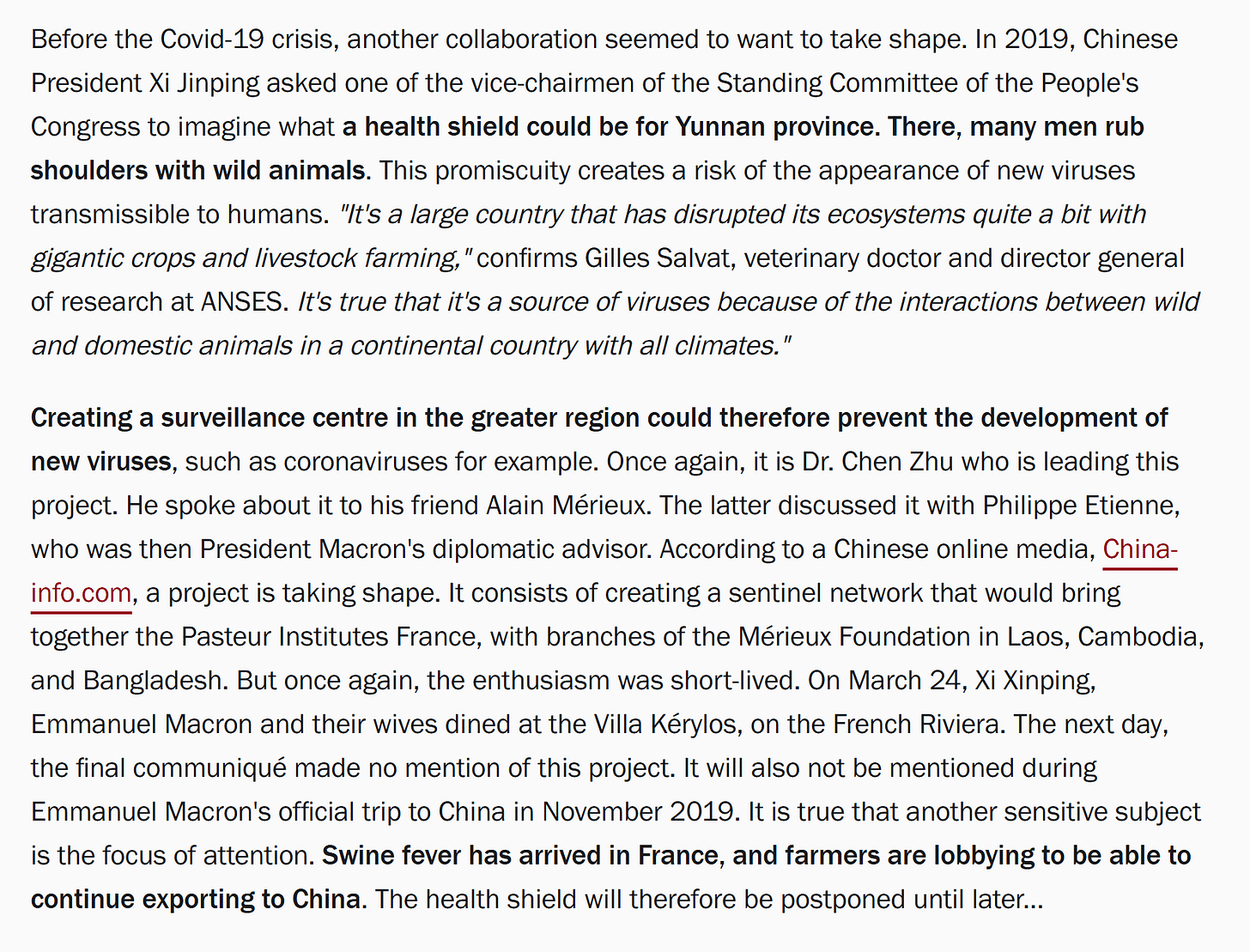
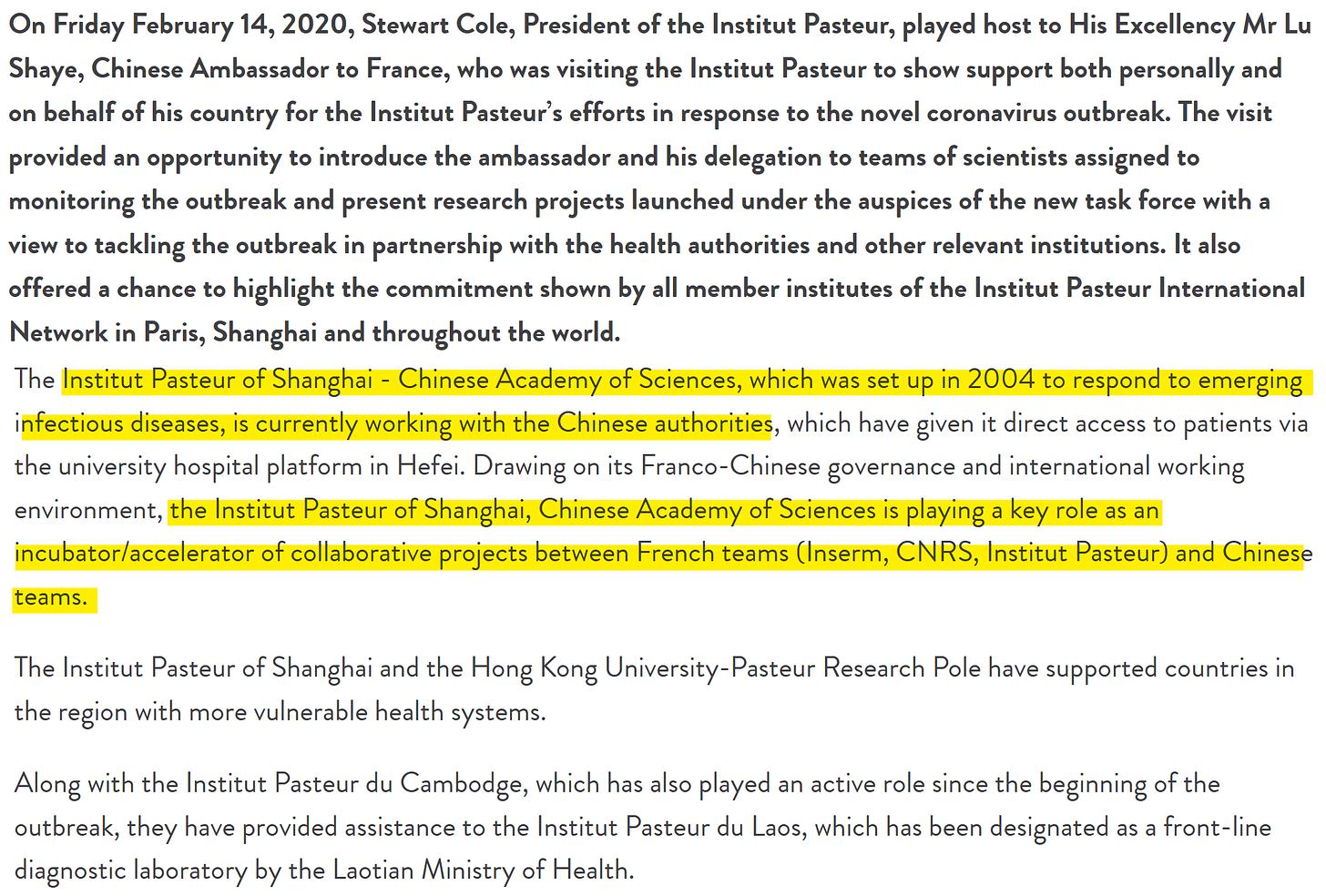
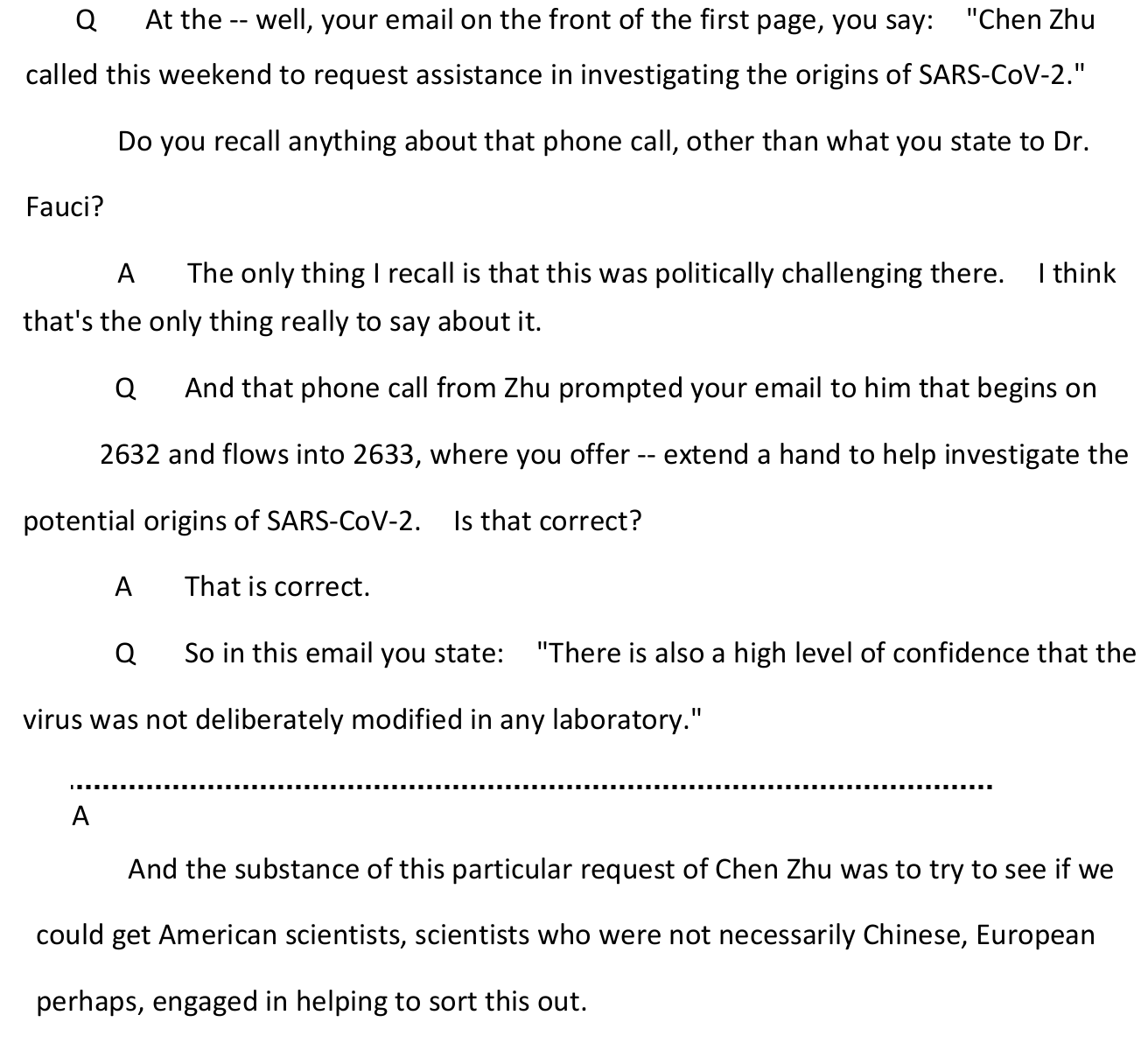


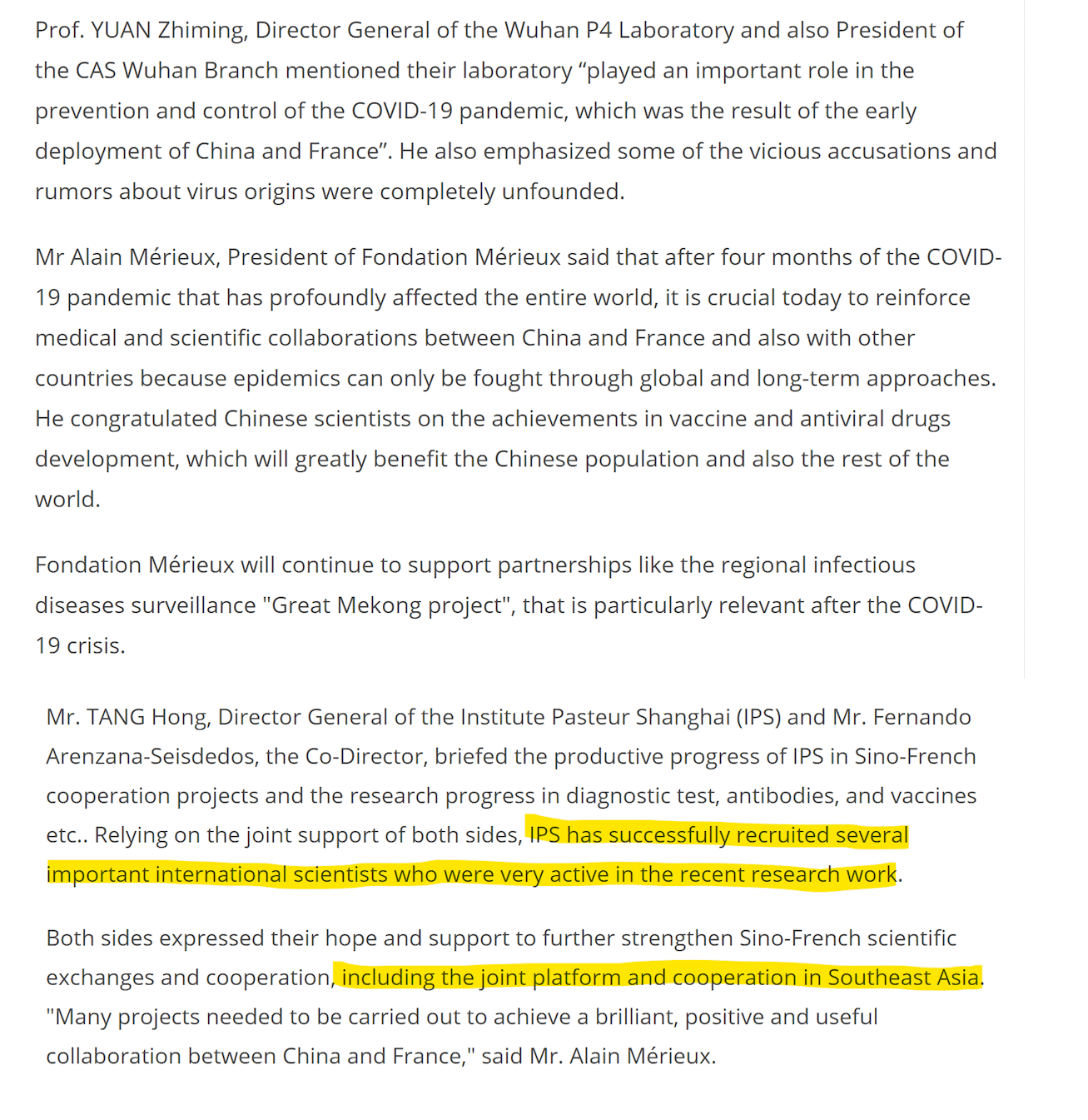

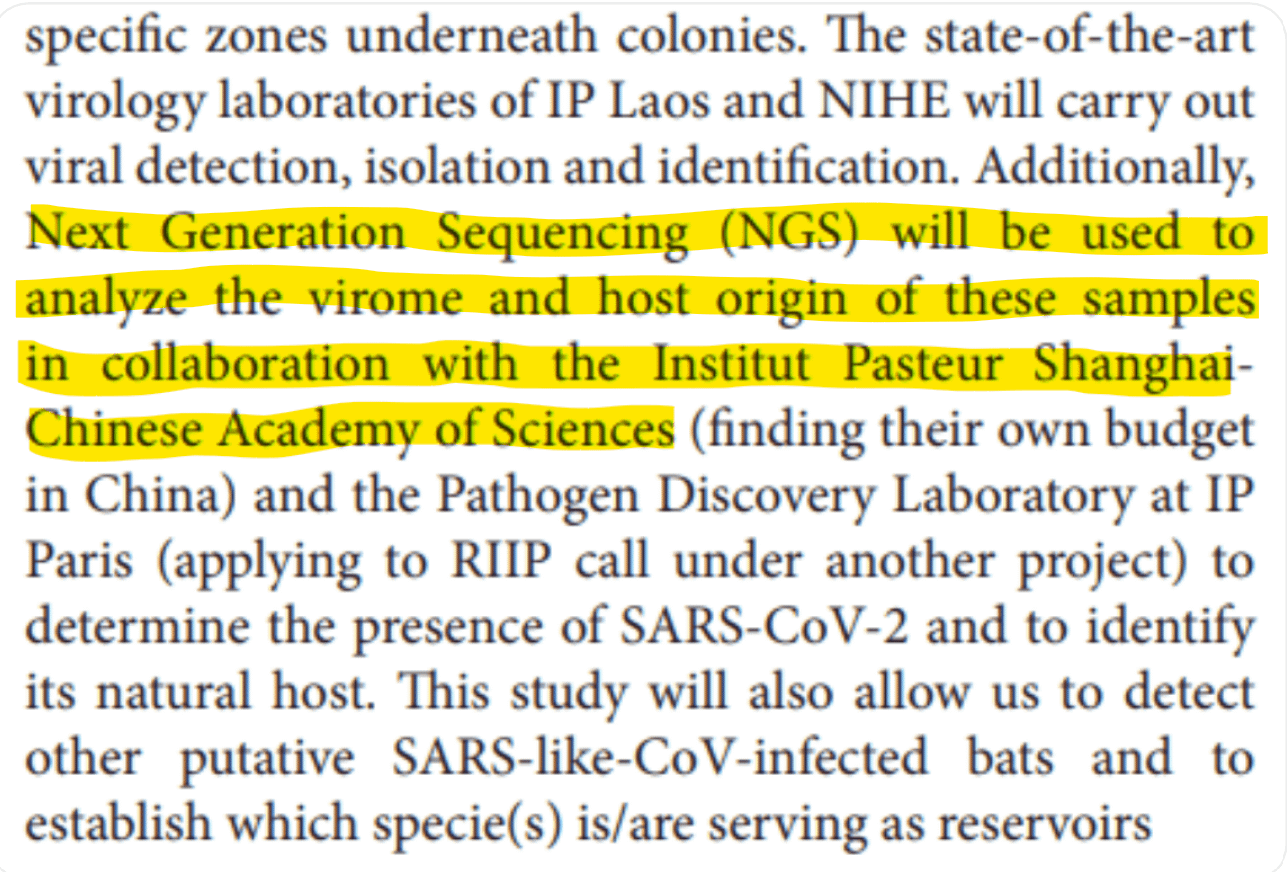
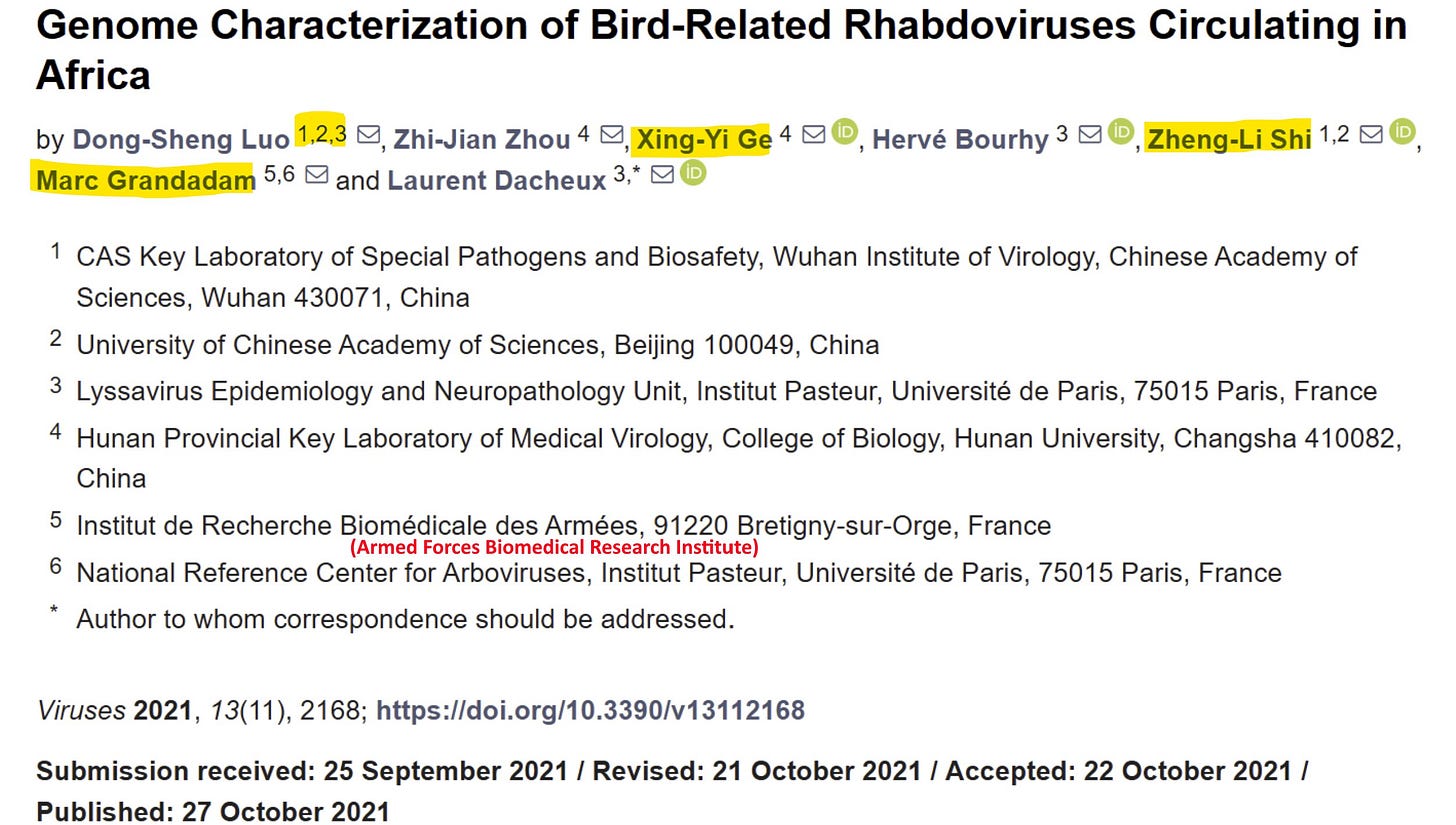

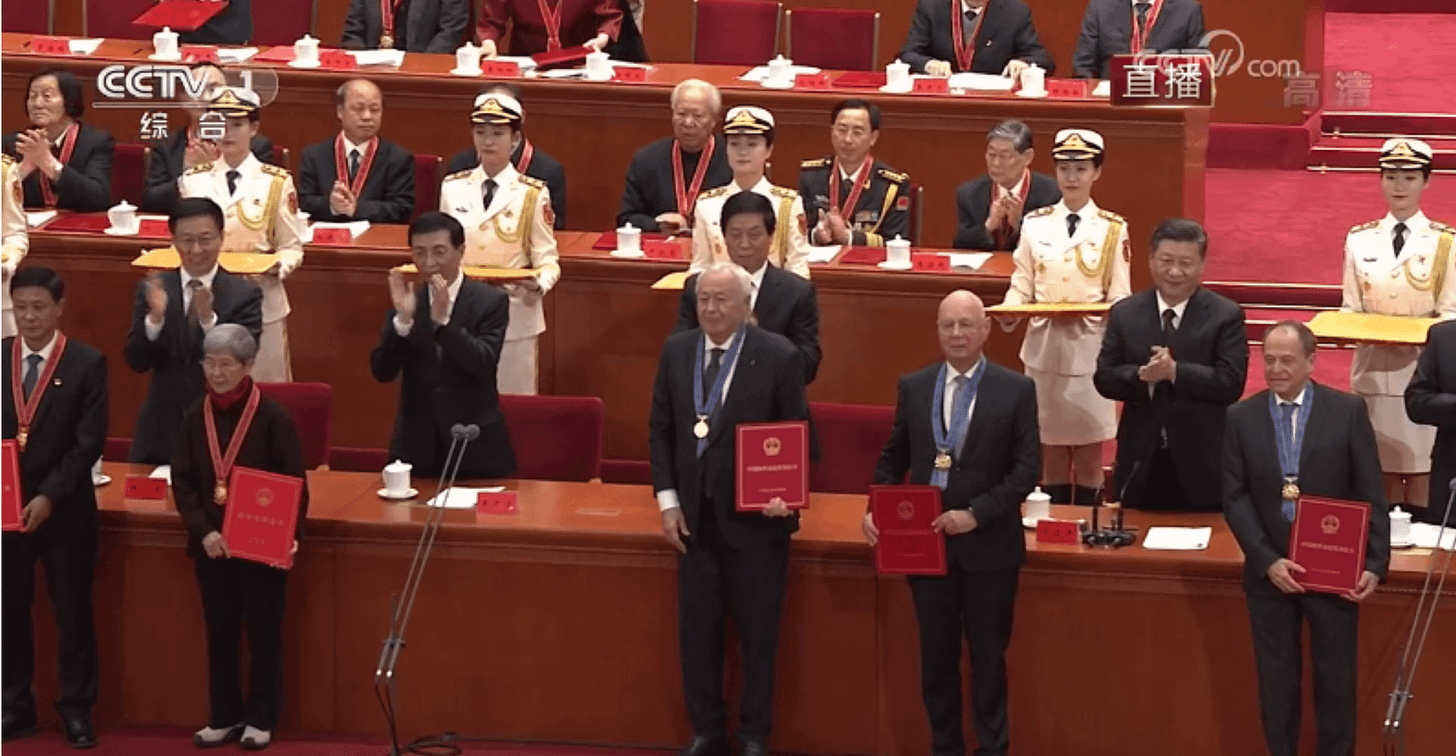

Could you share the articles from which the screenshots com? That would help.
I've added your Eloit email response to mine; he somehow claimed the 2017 and 2021 projects weren’t connected because he used different funding in the Materials and Methods section.
https://jimhaslam.substack.com/p/lets-be-blunt-the-us-government-collected